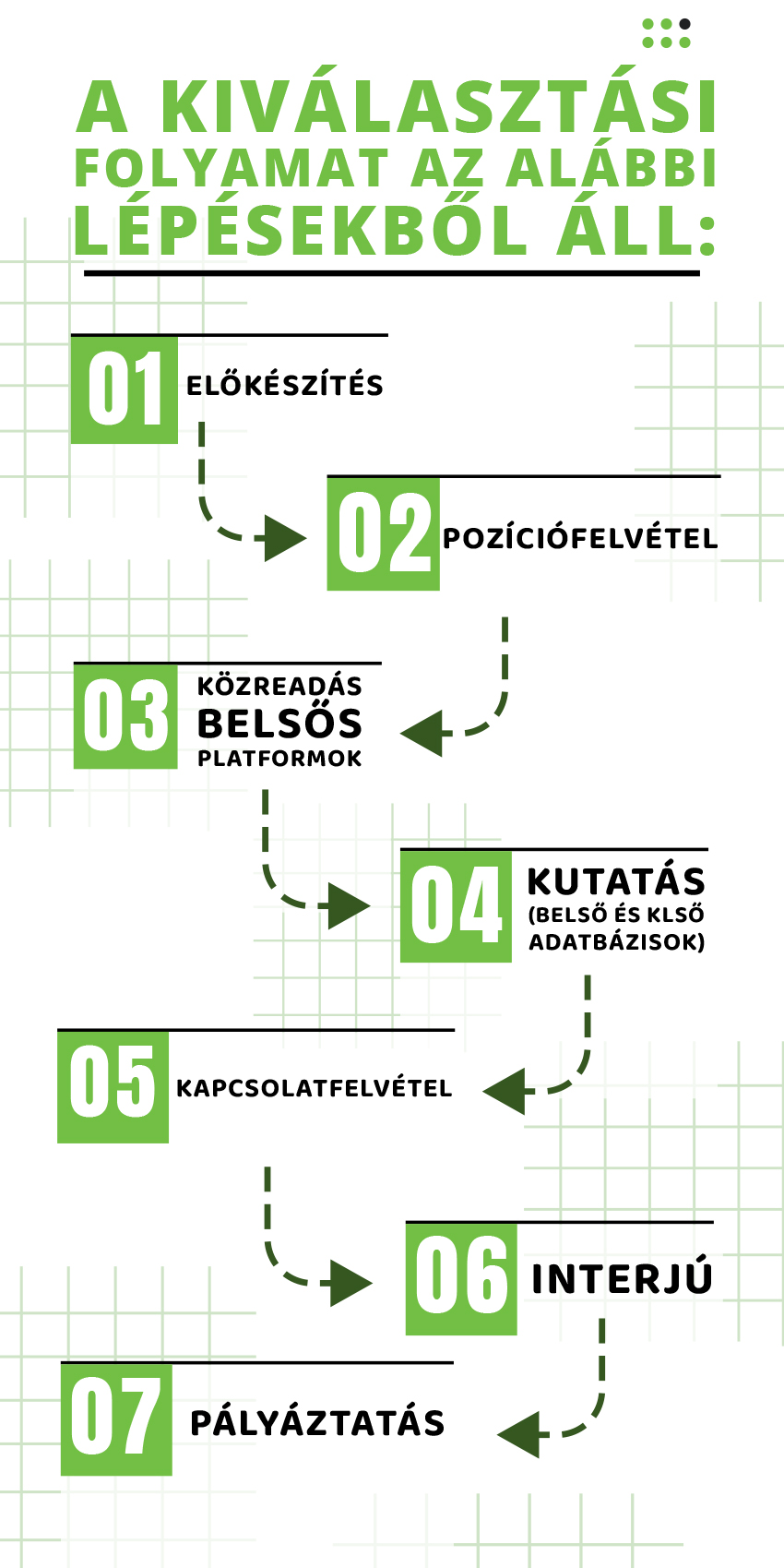Recruitment from A to Z
How we work
We’ll summarise the process you can expect when we start working together – and give you some useful tips to make your recruitment process go smoothly. In the current labour market and economic climate, management has to make particularly tough decisions, and when considering using a recruitment agency, there are many factors to consider. Here’s how we see the process from our perspective, so that you can get an accurate picture of the future work together and the specific steps of the candidate search process before the first meetings.
You can also read our previous articles to find out what happens from the moment you contact us and how we can help you as a jobseeker.
Recruitment and internal platforms
Once we have agreed the details of the recruitment assignment with the client and finalised the job description, the first step is to publish the job advertisement on IDBC’s own careers site.
This is followed up in a second step by posting it on our own established social media channels in a variety of formats, which allows us to reach potential candidates immediately.
First, we usually raise awareness of the new opportunity on LinkedIn, where we include a graphic illustrating the key features, a text summary of the job opportunity and a link to the full description on our website.
After our own channels, we then move on to the job portals, always adapting the portals on which we display the vacancy to the nature of the job. For example, in the IT field, No Fluff Jobs is typically the standard, but Profession also attracts a lot of visitors.
Finding and identifying the optimal candidates
Next, we look through various internal and external databases to select and target the optimal candidates for our clients.
All the candidates who have ever visited us are available in a maintained database, with properly labelled profiles and competences.
We start the search with an artificial intelligence (Zia) tool, which, when running the search, analyses the entire candidate profile and lists the candidates that appear optimal in the first round, based on their relevance to the position.
We also search online, and LinkedIn is our primary tool – we run searches there too. To optimise the searches, we use „Boolean-builder” utilities to create complex statements based on the position parameters. We use these Boolean parameters in our own database and on external job search platforms.
In addition, our recruiters also search for suitable candidates on various professional forums, social media groups. GitHub, Stack Overflow, Reddit, and Facebook groups, we also search and inquire on these sites. In a competitive position it is a tough fight for a good candidate, sometimes these searches in more „hidden” places lead to the best solution.
Getting in touch
After a successful search, we usually have a short telephone conversation with the candidate to discuss the possibilities. We introduce the client and the services involved. At this stage, we can see the candidate’s CV, but we also ask them what exactly they are looking for and review their experience to see what areas they would be open to.
Although a written enquiry is much more time-consuming than a telephone call, it is inevitable in the absence of a telephone number. Fortunately, there are modern tools to improve the efficiency of this phase too.
In addition to contacting you on LinkedIn, we use the HireEZ tool to set up optimised message sequences so that candidates are automatically contacted again at certain intervals. This is often very appreciated, as a little reminder can go a long way. It often makes or breaks whether or not the candidate will take the time to respond to our enquiry. Currently, we have a response rate of around 20-25% for our email contacts, which is a good rate for this genre.
When an active job seeker contacts us, we don’t always have a relevant position for them immediately. Fortunately, we are often able to offer them something immediately, but if there is no immediate opportunity, the candidate is entered into our internal system where we store their profile with various tags and markers. This way, the system will pick him up the next time we are looking for a position relevant to him.
Interview
During the telephone interview, we usually organise an interview. This typically takes place online for half an hour.
If we have called the candidate about a specific opportunity, the interview will focus on the position and the candidate’s experience. If he or she has applied with us, we will discuss the candidate’s experience and needs, and ask for his or her opinion on the first job opportunities that seem suitable for him or her.
Throughout the process, we focus on maintaining a high level of candidate experience. Above a certain professional level, it is particularly important that the professionals we approach experience this phase as an exciting professional conversation. The key to success is to thoroughly assess their needs, their situation and the tasks that currently interest them most.
We dedicate our expertise to finding the professional challenge that best suits your needs, so that we can act in your best interests. We build a friendly and long-lasting relationship, the tone and the main feature of the interview process is attentiveness, openness and a service attitude – client orientation is as fundamental in our candidate communication as it is towards the representatives of the companies looking for experts.
In this way, we want to make a strong and deliberate contrast with the ‘grinder’ attitude that candidates (especially particularly sought-after candidates) often encounter in their everyday lives. We offer a different type of service, more complex and value-oriented, and we strive to make this evident from the first moment.
This may seem to require a lot of work and effort: this is fundamentally true, but it pays off because it actually increases the chances that the candidate will make the right choice, is more likely to stay with the company in the long term and, in turn, the company that hires us gets the highest value (a win-win-win situation for all three parties involved).
How to apply
The IDBC will optimally place three candidates for an open position in one week.
If we have succeeded in attracting a candidate’s interest in a position, we will notify the client and send the candidate’s file.
At this point we can provide important assistance to both parties by managing the candidate. On the one hand, we present the profile in a way that fits the expectations of the position. We prepare an extract from the CV, i.e. we put together material that is optimal in form and practice for the job application
This takes the burden of writing a good CV off the candidate and helps the company by presenting what is really relevant. For each position, we create a slightly different CV, always focusing on the competencies and experience that fit the position.
If the client calls the candidate in for an interview, we will prepare the candidate based on what we have learned from you about the selection process. We will share with the candidate basic technical information (how many rounds there will be, what the responsibilities are, etc.) and the background information we have about the company, for example, culture, selection priorities.

A teljes folyamat során heti státuszmegbeszéléseken számolunk be a szituációról, a megbízóval közösen menedzselve a projektet.
Tips for successful recruitment
The above summarises the essence of the IDBC methodology. Of course, the future employer himself has a lot to contribute to attracting the best staff. Here are a few ideas we recommend you consider:
The most typical problem with clients, from our observations, is the delay in response. We stress that companies should do all they can to speed up this process, because it is extremely frustrating, but also very common, for the very costly, multi-round, multi-actor recruitment process to fall through because others have buried the candidate while waiting.
In general, we ask for and recommend a maximum response time of two days for each phase, for sending out the profile as well as for the post-interview briefing on the next step.
Another suggestion for all companies is to break with a widespread practice of accepting candidates even if they are already on their database. In many cases, they would be relevant, but they just overlooked it or for some reason it didn’t show up in the internal screening process, even though we think it looks good.
In such cases, the company does not want the agency to contact someone they already know. However, that’s fine, the company can of course continue the process in-house and contact the person – in which case our role is simply to make them aware. This can also be an important asset, especially if you are then hired.
It is a waste of everyone’s time if the company offers the candidate a salary below the communicated salary range at the very end of the process. This also leads to a breach of trust, as the candidate would not even be there if that had been the amount originally quoted. This is why we stress the importance of realistic salary ranges to both our clients and job seekers.
As you can see from the summary at the beginning of this article, the identification process involves many phases, we use advanced digital tools, we work in teams – but sometimes it’s not enough. Because our methodology is tried and tested, a complete or partial failure of the search may also indicate that there may be room for improvement in the wording and details of the position. Something should be changed because the call for proposals in its current form is not proving attractive enough. Of course, an increase in the salary attached to the position can often help, while in other cases flexibility linked to working hours and office presence is the key factor.
Another solution may be for the company to try to tailor the position more closely to the current career goals of the optimal candidate. Professionals sometimes attach conditions to the contract such as eligibility for professional training or promotion.
We recently ran a three-part series on what companies can do to recruit successfully in the IT space, so if this is relevant to you, it’s worth a read. The first part focuses on identification, the second part on recruitment, and the third part looks at what it takes to keep a new hire in the company for a long time. If you enjoyed the article, please share it with others and subscribe to IDBC’s newsletter so you don’t miss out on the latest recruitment trends, updates and advice and contact us for personalised consulting.










